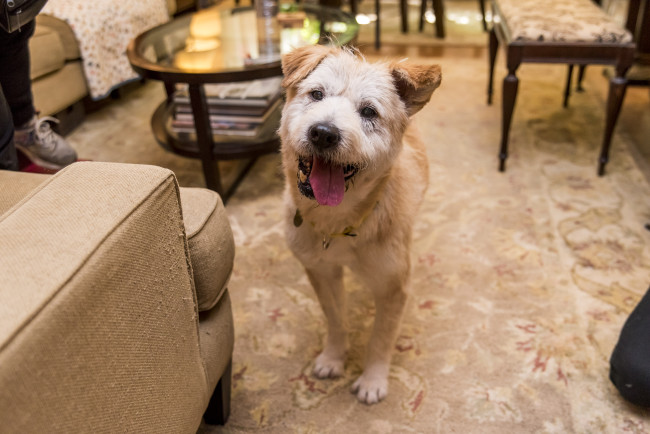How to introduce your new pet to the neighbors—and keep the peace

Although New York City, with its crowds, noise, and concrete, may seem at first glance like a potentially overwhelming place for animals, in some ways, it can be pretty pet-friendly. Consider one of today's most in-vogue building amenities: pet spas, which, the New York Times reports, have grown into elaborate spaces that offer haircuts and treadmill walks.
But while one broker quoted in the story estimates that half of all residential buildings in the city allow pets—there's no hard-and-fast statistic—not everyone welcomes animals with open arms. Take the story of Lucy, a basset hound who so enraged the neighbors in the Queens co-op where she and her owner lived that they sent threatening notes.
It seems that Lucy's all-night barking sent some residents over the edge. Besides being annoying, such noise disturbances can also cross over into illegal territory. According to MFY Legal Services, New Yorkers and their furry companions can be evicted if a pet is deemed a nuisance, meaning the animal is excessively noisy or aggressive, or causing messes in public areas of the building.
It needn't get to that point, though, with a little effort on your end to train your pet, and charm your neighbors.
Prep your pet for its new home
If this will be the first time your pooch will be living in an apartment, it's understandable that he or she might be a little jumpy. With their territorial natures, dogs might be inclined to bark when they hear neighbors moving about next door or in the hallway; energetic puppies can also generate plenty of noise tearing around your space.
You could also search for quieter breeds from the outset—check out our guide to the best breeds for apartment-dwellers for some ideas. And once you've brought a dog home, there are steps you can take to cut down on barking.
Dana Ebbecke, an animal behavior counselor at the ASPCA Adoption Center, advises doing a "trial night" at a pet-friendly hotel: Notice if your dog seems to take the move in stride, or if the new environment makes them a bit nervous. Pay attention to how your dog responds to hearing people moving in the hallways. "If your dog barks or appears agitated by the additional movement, this can help you know what to work on when you transition to an apartment," she says.
If this test run reveals your pup might be nervous in an apartment building, there are options for mitigating noise and reinforcing quieter behavior. Ebbecke suggests calming your pet by using white noise machines or the radio to drown out some of the sounds from the hallway, which can be unpredictable (think slamming doors and sudden elevator pings that don't happen on a schedule). Positive reinforcement helps: Offer treats when they don't bark at passersby.
Alana Serota, a New Yorker who adopted a puppy recently, lives in a corner unit that makes it possible for her to keep her dog in a crate that's far from her neighbors. Even if you aren't tucked in a corner spot, consider positioning a crate or bed away from doors that open onto common spaces like the elevator landing. Also, consider purchasing area rugs to mask the noise of the pitter-patter of little dog feet.
You should also take your dog on "tours" around the apartment building, to help acclimate them to the space and the people. "Reward your dog for calm and polite behavior while walking through the building," Ebbecke advises. "If your dog is uncomfortable moving around the building, try taking him out during times when he’s less likely to encounter things and build up his confidence."
Making sure your dog is walked as much as he or she needs is a must. Per PetMD, dogs that don't get sufficient exercise may resort to destructive behaviors in your home. And if your pooch cries while you're away from separation anxiety, give them a long-lasting chew or toy right before you head to keep them busy, Ebbecke adds. If all else fails, the city abounds in dog-walking services and doggy day cares. Even with a calmer dog, this may be worth considering if you're out for many hours at a stretch.
Give your neighbors the heads up—and deal tactfully with difficult ones
Before you bring home the new member of the family, it may help to let your neighbors know. Serota suggests sharing the news with a cute and creative touch, living giving bone-shaped cookies to the building staff and adjacent neighbors.
Lynn Saladino, a clinical psychologist who acts as a health and wellness consultant for Mirador Real Estate, agrees that it's important to take a friendly approach to setting expectations. "I've seen people put signs on their door saying that they're getting a pet, and if you have a problem please come and contact us. What people react to is when someone is blindly inconsiderate about it. It's about showing that you do care, and that you're aware this is going to impact them," she says.
At the same time, don't be overly apologetic: "You don't have to completely explain yourself, especially if you're in a building that accepts animals," Saladino adds.
Once you've brought your pet home, keep in mind that first impressions can matter with animals as much as they do with people. Serota recalls, "One cranky lady gave us the business about having the dog in the lobby—strictly speaking it is against the rules." She notes, though, that winning over her building's doorman has meant she can get away with hanging out there with her pooch.
Ebbecke suggests investing in early behavioral training, as a dog that knows how to greet new people appropriately (for example, no jumping) and can sit or do other tricks on cue is bound to leave neighbors with more positive feelings. "If your dog isn’t comfortable meeting new people, hold off introducing him until he feels more confident saying hello," she says.
Even if you give it your best effort, though, you may be faced with neighbors who verge on intolerant. One blogger for Dogster recalls a woman who was convinced her pet reeked, spraying air freshener in the hallways and complaining to building management. If your neighbor's frustration is palpable—or you're concerned about being reported to the landlord, the board, or 311—it's time for mediation.
Debra Vey Voda-Hamilton, a lawyer who specializes in mediating animal conflicts, tells Pet360 that it's important to start a conversation from an undefensive stance. Try to listen to your neighbor's grievances without feeling personally attacked, so that your focus is on problem-solving rather than fear or frustration.
"I always try to elicit from the other person, What would you recommend that I do?" Saladino says. Then, when your neighbor makes suggestions, "Simply say you can or cannot do that. Try to have a conversation with them that's really positive."
She adds that it can help your own peace of mind to understand that your neighbor's unhappiness is not, at the end of the day, primarily your responsibility. "At a certain point, especially in New York, we're all looking for an avenue for our stress," she points out, "It may partially be about your dog, but it's probably also the other 100 things that happened during the day. I think you give it your best effort to be kind and understanding, but you have the right to be there as much as they do."
And there's strength in numbers: If you're in a building that allows pets, chances are there are other dog owners nearby whom you could turn to for advice and commiseration. In an article for Brick about keeping a dog in NYC, Alyse Whitney suggests visiting neighborhood dog runs to meet fellow pet-parents.
"I love the community aspect of NYC so much," says Saladino. "Make friends in the building who are in similar situations—it can really go a long way."
You Might Also Like


























